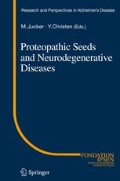Abstract
The notion that many neurodegenerative diseases are caused by seeded protein aggregation is almost 20 years old (Jarrett and Lansbury, Cell 73:1055–1058, 1993; Lansbury, Neuron 19:1151–1154, 1997). Recent data, some of it summarized here, suggest that this mechanism may account for cell-to-cell transmission throughout the brain by “proteopathic seeds.” There are many scientific questions that remain to be solved, including what is the best approach to interfere with the seeding process in vivo. But it may be more important to address the practical bottleneck that is common to all therapeutic strategies: how can one demonstrate potential efficacy of an experimental drug in a small, inexpensive clinical trial? This manuscript will address the issues that, together, have produced this bottleneck and will suggest some possible approaches to stimulate drug development for neurodegeneration.
Access this chapter
Tax calculation will be finalised at checkout
Purchases are for personal use only
References
Boche D, Denham N, Holmes C, Nicoll JA (2010) Neuropathology after active Aβ42 immunotherapy: implications for Alzheimer’s disease pathogenesis. Acta Neuropathol 120:369–384
DiMasi JA, Grabowski HG (2012) R&D costs and returns to new drug development: a review of the evidence. In: Danzon PM, Nicholson S (eds) Tufts Center for the Study of Drug Development. March/April CSDD Impact Report. The Oxford handbook of the economics of the biopharmaceutical industry. Oxford University Press, Oxford, pp 21–46
Jarrett JT, Lansbury PT (1993) Seeding the “one-dimensional crystallization” of amyloid: a pathogenic mechanism in Alzheimer’s disease and scrapie? Cell 73:1055–1058
Lansbury PT (1997) Structural neurology: are seeds at the root of neuronal degeneration? Neuron 19:1151–1154
Maarouf CL, Daugs ID, Kokjohn TA, Walker DG, Hunter JM, Kruchowsky JC, Woltjer R, Kaye J, Castaño EM, Sabbagh MN, Beach TG, Roher AE (2011) Alzheimer’s disease and non-demented high pathology control nonagenerians: comparing and contrasting the biochemistry of cognitively successful aging. PLoS One 6:e27291
Petsko GA (2011) Bailing out. Genome Biol 12:131–133
Reed MN, Liu P, Kotilinek LA, Ashe KH (2010) Effect size of reference memory deficits in the Morris water maze in Tg2576 mice. Behav Brain Res 212:115–120
Savva GM, Wharton SB, Ince PG, Forster G, Matthews FE, Brayne C (2009) Medical Research Council Cognitive Function and Ageing Study. Age, neuropathology, and dementia. N Engl J Med 360:2302–2309
Selkoe DJ (2011) Resolving controversies on the path to Alzheimer’s therapeutics. Nat Med 17: 1060–1065
Sperling RA, Jack CR, Aisen PS (2011) Testing the right target and right drug at the right stage. Sci Transl Med 3:111
Takeda press release (2011) http://www.takeda.com/press/article_39958.html
Townsend M, Qu Y, Gray A, Wu Z, Seto T, Hutton M, Shearman MS, Middleton RE (2010) Oral treatment with a gamma-secretase inhibitor improves long-term potentiation in a mouse model of Alzheimer’s disease. J Pharmacol Exp Ther 333:110–119
Author information
Authors and Affiliations
Corresponding author
Editor information
Editors and Affiliations
Rights and permissions
Copyright information
© 2013 Springer-Verlag Berlin Heidelberg
About this chapter
Cite this chapter
Lansbury, P.T. (2013). Development of Drugs That Target Proteopathic Seeds Will Require Measurement of Drug Mechanism in Human Brain. In: Jucker, M., Christen, Y. (eds) Proteopathic Seeds and Neurodegenerative Diseases. Research and Perspectives in Alzheimer's Disease. Springer, Berlin, Heidelberg. https://doi.org/10.1007/978-3-642-35491-5_10
Download citation
DOI: https://doi.org/10.1007/978-3-642-35491-5_10
Published:
Publisher Name: Springer, Berlin, Heidelberg
Print ISBN: 978-3-642-35490-8
Online ISBN: 978-3-642-35491-5
eBook Packages: Biomedical and Life SciencesBiomedical and Life Sciences (R0)

